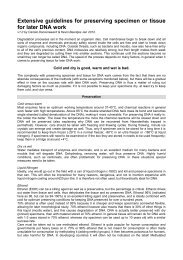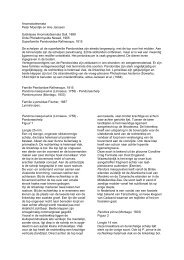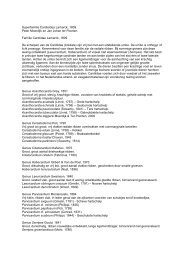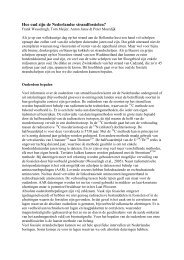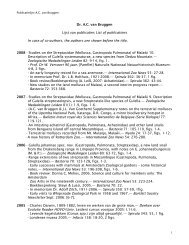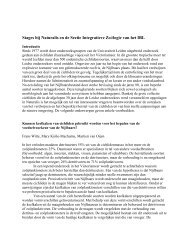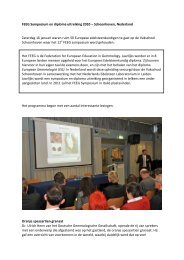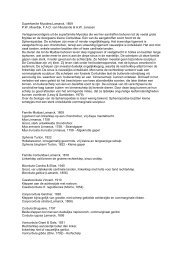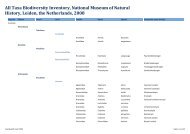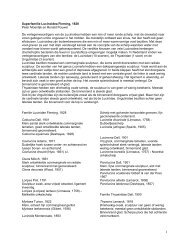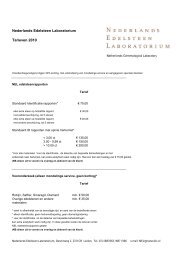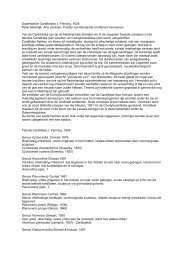The Odonata of Sulawesi and adjacent islands ... - science . naturalis
The Odonata of Sulawesi and adjacent islands ... - science . naturalis
The Odonata of Sulawesi and adjacent islands ... - science . naturalis
You also want an ePaper? Increase the reach of your titles
YUMPU automatically turns print PDFs into web optimized ePapers that Google loves.
Libellago <strong>and</strong> Sclerocypha <strong>of</strong> <strong>Sulawesi</strong><br />
<strong>The</strong> present paper is the 7th part <strong>of</strong> a series on the <strong>Odonata</strong> fauna <strong>of</strong> <strong>Sulawesi</strong> (part<br />
6, see van Tol 2007b), <strong>and</strong> focuses on the descriptions <strong>of</strong> the <strong>Sulawesi</strong> taxa <strong>of</strong><br />
Libellago <strong>and</strong> Sclerocypha, completing the revision <strong>of</strong> the Chlorocyphidae <strong>of</strong> this<br />
isl<strong>and</strong>, except Rhinocypha <strong>and</strong> Disparocypha (see also van Tol 1998). <strong>The</strong> relation -<br />
ships <strong>of</strong> the species described in the present paper, <strong>and</strong> the biogeographical implications,<br />
are further discussed in another paper (van Tol & Gassmann 2007).<br />
Material <strong>and</strong> methods<br />
This study is mainly based on specimens preserved in the National Museum <strong>of</strong> Natural<br />
History Naturalis, Leiden (RMNH). Further specimens were received on loan<br />
from the Zoologisches Museum der Humboldt Universität, Berlin (ZMHB), Senckenberg<br />
Museum, Frankfurt (SFMD); National Museums <strong>of</strong> Scotl<strong>and</strong>, Edinburgh<br />
(RSME), <strong>and</strong> the Royal Belgian Institute <strong>of</strong> Natural Sciences, Brussels (IRSN). André<br />
Günther (Freiberg) kindly <strong>of</strong>fered his reference collection <strong>of</strong> <strong>Sulawesi</strong> Chlorocyphidae<br />
for this study.<br />
Specimens were studied with various microscopes (Leica, Zeiss), the illustrations<br />
prepared with a camera lucida. <strong>The</strong> colour photographs were made with Nikon cameras<br />
with 60 mm or 200 mm Micro-Nikkor lenses, using Kodachrome or Fuji film.<br />
Terminology, including that <strong>of</strong> wing venation, follows Watson & O'Farrell (1991).<br />
Terms as ‘anterior’ <strong>and</strong> ‘posterior’ for markings on the synthorax are used according<br />
to the orientation in preserved specimens. Due to secondary rotation <strong>of</strong> the thorax,<br />
the ‘posterior’ side <strong>of</strong> markings technically is the ‘dorsal’ side.<br />
<strong>The</strong> term ‘Sg.’ on many labels is an abbreviation for ‘Sungai’, meaning ‘stream’ or<br />
'river'.<br />
Characters in Chlorocyphidae<br />
As with most Calopterygoidea, representatives <strong>of</strong> the family Chlorocyphidae show<br />
extensive territorial <strong>and</strong> courtship behaviour in the imaginal stage. Orr (1996) autho -<br />
ritatively describes the morphological, especially the ornamental, features <strong>of</strong> the Bornean<br />
species <strong>of</strong> the Chlorocyphidae in relation to these behavioural aspects. Pre -<br />
sumably owing to the complex precopulatory behavioural mechanisms <strong>of</strong> species recognition,<br />
the diversity <strong>of</strong> morphological characters in the genitalia is remarkably low<br />
(e.g. Cowley 1937; Laidlaw 1950). Apparently, premating isolation by behavioural<br />
mechanisms (e.g. Paulson 1981; Robertson 1982a, b; Tennessen 1982) is such, that<br />
there is no evolutionary pressure for morphological radiation in this group. Also the<br />
larval stages provide little information on the higher phylogenetic relationships.<br />
<strong>The</strong> absence <strong>of</strong> structural diversity causes serious difficulties in establishing the taxonomy<br />
<strong>of</strong> this group. <strong>The</strong> focus on coloration for species recognition is usually unsatisfactory,<br />
especially when it is considered that, in the Chlorocyphidae, remark -<br />
able superficial similarity occurs even between species with distinct structural<br />
characters at the generic level (cf. van Tol 1998). <strong>The</strong> present paper is restricted to<br />
an analysis <strong>of</strong> the morphological <strong>and</strong> ornamental features. For most taxa colour<br />
photo graphs were available. <strong>The</strong>se colour pictures are included in this paper, since<br />
they show most clearly the significant differences in living colours <strong>of</strong> the various<br />
taxa described. <strong>The</strong> differences in preserved specimens are much more subtle, as is<br />
reflected in the descriptions.<br />
International Journal <strong>of</strong> Odonatology 10 (2) 2007: 209-248, pls II, III 211



